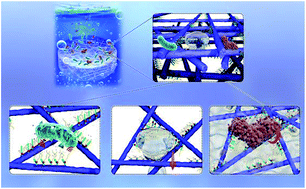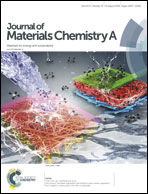A high-efficiency ultrafiltration nanofibrous membrane with remarkable antifouling and antibacterial ability†
Abstract
Fouling in ultrafiltration (UF) membranes for water treatment results in a decrease in filtration efficiency and a deterioration in water quality. In this work, a self-supporting hydrophilic nanofibrous membrane was obtained by mixing multi-arm amphiphilic fluxible poly(p-phenylene terephthalamide) (f-PPTA) with poly(vinylidene fluoride) (PVDF) in solution followed by an electrospinning process. Notably, f-PPTA migrated to the nanofiber surface owing to its self-mobility and induction by the electric field force. Therefore, hydrophilic chains provided by f-PPTA greatly increased the wettability of the whole membrane, since f-PPTA was introduced during the membrane preparation. The multi-arm f-PPTA acted as the water channel in the nanofibrous membrane, accelerating the flow of water molecules through the membrane. The increasing electric field force caused by f-PPTA had a great effect on regulating the nanofiber diameter and pore size of the nanofibrous membrane, which further influenced the filtration performance. Consequently, the pure water flux reached 8.3 × 104 L (m2 h)−1 at 0.2 MPa when the f-PPTA addition amount was 20 wt% of PVDF, which was 2.3 times higher than that of the neat PVDF nanofibrous membrane. Undoubtedly, amphiphilic f-PPTA proved to show excellent compatibility with PVDF, which avoided the problems of hydrophilic polymers being washed away easily and inorganic nanoparticle aggregation, and hence the modified nanofibrous membranes exhibited a relatively stable filtration flux. After operation for 6 h the membrane retained approximately 89% of the initial flux and protein rejection also remained at 98.7%. The membrane with more hydrophilic chains improved the antifouling ability preventing the membrane surface and inside pore structure from being fouled. Additionally, as a polymer-based antibacterial agent, f-PPTA also played a key role in improving the antibacterial activity. Overall, the membrane achieved a comprehensive performance of a sustainable high permeation flux, and remarkable antifouling and antibacterial activities, thus becoming a promising candidate for UF applications in water treatment.



 Please wait while we load your content...
Please wait while we load your content...